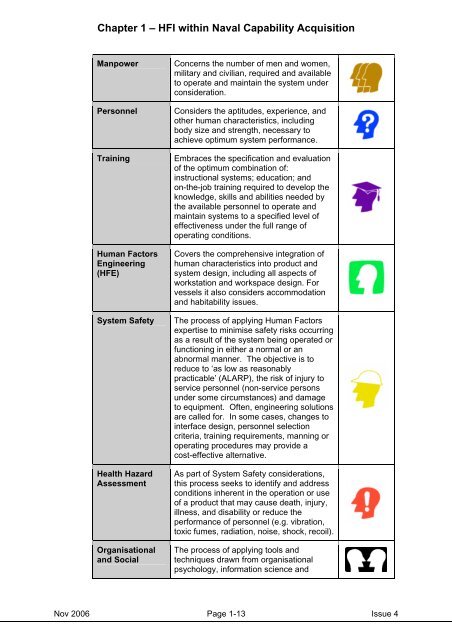MAP-01-010 HFI Management Guide - Human Factors Integration ...
MAP-01-010 HFI Management Guide - Human Factors Integration ...
MAP-01-010 HFI Management Guide - Human Factors Integration ...
You also want an ePaper? Increase the reach of your titles
YUMPU automatically turns print PDFs into web optimized ePapers that Google loves.
Chapter 1 – <strong>HFI</strong> within Naval Capability Acquisition<br />
Manpower<br />
Personnel<br />
Training<br />
<strong>Human</strong> <strong>Factors</strong><br />
Engineering<br />
(HFE)<br />
System Safety<br />
Health Hazard<br />
Assessment<br />
Organisational<br />
and Social<br />
Concerns the number of men and women,<br />
military and civilian, required and available<br />
to operate and maintain the system under<br />
consideration.<br />
Considers the aptitudes, experience, and<br />
other human characteristics, including<br />
body size and strength, necessary to<br />
achieve optimum system performance.<br />
Embraces the specification and evaluation<br />
of the optimum combination of:<br />
instructional systems; education; and<br />
on-the-job training required to develop the<br />
knowledge, skills and abilities needed by<br />
the available personnel to operate and<br />
maintain systems to a specified level of<br />
effectiveness under the full range of<br />
operating conditions.<br />
Covers the comprehensive integration of<br />
human characteristics into product and<br />
system design, including all aspects of<br />
workstation and workspace design. For<br />
vessels it also considers accommodation<br />
and habitability issues.<br />
The process of applying <strong>Human</strong> <strong>Factors</strong><br />
expertise to minimise safety risks occurring<br />
as a result of the system being operated or<br />
functioning in either a normal or an<br />
abnormal manner. The objective is to<br />
reduce to ‘as low as reasonably<br />
practicable’ (ALARP), the risk of injury to<br />
service personnel (non-service persons<br />
under some circumstances) and damage<br />
to equipment. Often, engineering solutions<br />
are called for. In some cases, changes to<br />
interface design, personnel selection<br />
criteria, training requirements, manning or<br />
operating procedures may provide a<br />
cost-effective alternative.<br />
As part of System Safety considerations,<br />
this process seeks to identify and address<br />
conditions inherent in the operation or use<br />
of a product that may cause death, injury,<br />
illness, and disability or reduce the<br />
performance of personnel (e.g. vibration,<br />
toxic fumes, radiation, noise, shock, recoil).<br />
The process of applying tools and<br />
techniques drawn from organisational<br />
psychology, information science and<br />
Nov 2006 Page 1-13 Issue 4
















